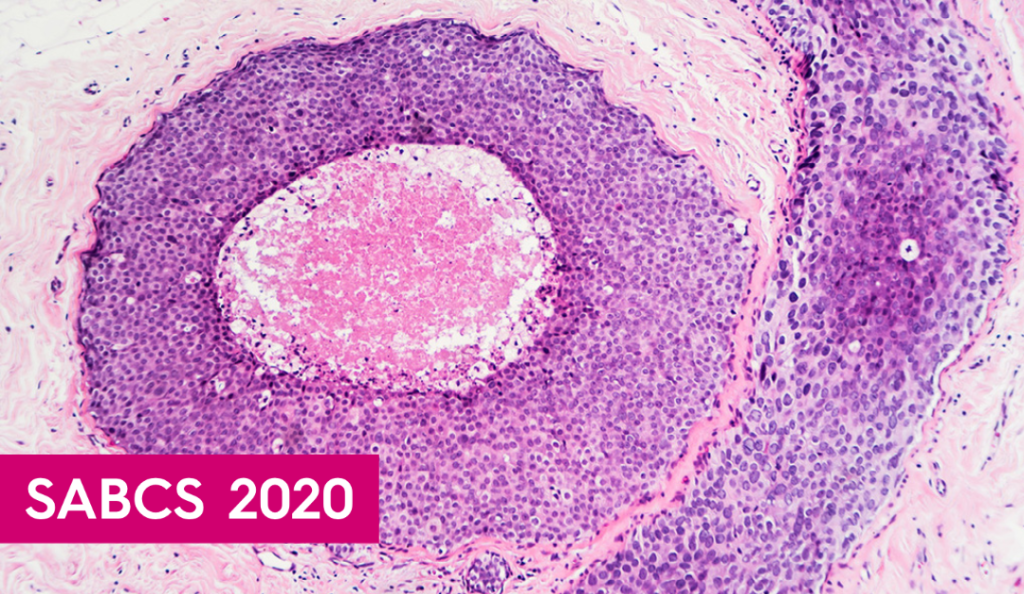Studies looked at ways to improve risk prediction and dug deeper into the biology of stage 0 breast cancer
Ductal carcinoma in situ (DCIS), also called stage 0 breast cancer, is a noninvasive precursor of breast cancer. The term “in situ” means “in place,” so named because it has not spread from the duct into the surrounding breast tissue. About 60,000 people are diagnosed with DCIS in the U.S. each year, and anywhere from 14-53 percent of those cases will progress to invasive disease.
Currently, there is no way to predict whether a case of DCIS will become invasive cancer, so it is treated similarly to invasive breast cancer. DCIS is removed surgically, often treated with radiation and, if the DCIS is hormone receptor (HR)-positive, five years of tamoxifen (in pre- and post-menopausal women) or an aromatase inhibitor (in post-menopausal women). This thorough treatment lowers the risk of DCIS recurring or invasive cancer developing.
At this year’s San Antonio Breast Cancer Symposium (SABCS), investigators reported research findings and insights into optimizing DCIS treatment and understanding its fundamental biology.
Improving risk prediction and decision-making
Because prognostic biomarkers are lacking in DCIS and many diagnoses will never become life-threatening, another potential approach to its management is to watch closely and wait. This concept of active monitoring (AM), also used for some low-risk cancers, is the basis of the COMET trial led by BCRF researchers Drs. Shelley Hwang, Ann Partridge, and colleagues. Patients enrolled in the study are randomized to the current standard treatment for DCIS (surgery with or without radiation and five years of hormone therapy for HR-positive DCIS) or AM and five years of hormone therapy if needed. The COMET investigators hope to demonstrate that patients with low-risk DCIS will do just as well with AM and hormone therapy as those who have standard treatment.
Other efforts to improve risk prediction and decision making in pre-invasive cancer include the Breast PreCancer Atlas initiative headed by Drs. Hwang, Robert West, and Carlo Maley of the Biodesign Institute at Arizona State University. The goal: to characterize tumor evolution from pre-invasive to invasive disease to better stratify DCIS and provide evidence-based recommendations for personalized management. At SABCS, Dr. Hwang provided a brief update on analyses from two independent cohorts of patients diagnosed between 1981-2014 from the Translational Breast Cancer Research Consortium and the Washington University Repository of Archival Human Breast Tissue. The results suggested the microenvironment surrounding DCIS may influence its progression to invasive breast cancer. Dr. Hwang noted that the PreCancer Atlas represents a data-rich resource to ultimately guide further DCIS research and clinical decisions.
Deepening our understanding of the biology of DCIS
Further uncovering the molecular features of DCIS and its surrounding microenvironment is critical both to understand what drives it to become invasive breast cancer and to have indicators of that likelihood. Distinctive biomarkers could become an invaluable tool for clinicians to gauge the risk of DCIS progression to invasive breast cancer and enable them to make more informed decisions about managing individual cases.
BCRF investigator Dr. Laura Esserman and colleagues presented a study profiling the tumor immune microenvironments in patients with high-risk DCIS. They examined 100 patient samples that were considered likely to progress to invasive disease. The results showed clear genetic differences between DCIS and benign regions of each sample. Strikingly, they also observed that the immune landscape varied tremendously not only among samples but also within different regions of individual DCIS samples. Their observations underscore the complexity of DCIS and the need for more personalized treatment approaches.
Multiple other studies were discussed that similarly aim to unravel the biology of DCIS and its surrounding microenvironment, with the majority of work pinpointing genetic and molecular characteristics of DCIS that are correlated with tumor progression. Advances in genomic sequencing, comprehensive immune profiling, and the increased availability of high-quality DCIS patient samples are facilitating this innovative DCIS research at the most granular level. The research presented at SABCS this year highlights the importance of deciphering these factors in DCIS to gain deeper insight into breast cancer’s roots.
Read more of BCRF’s SABCS 2020 coverage here.

